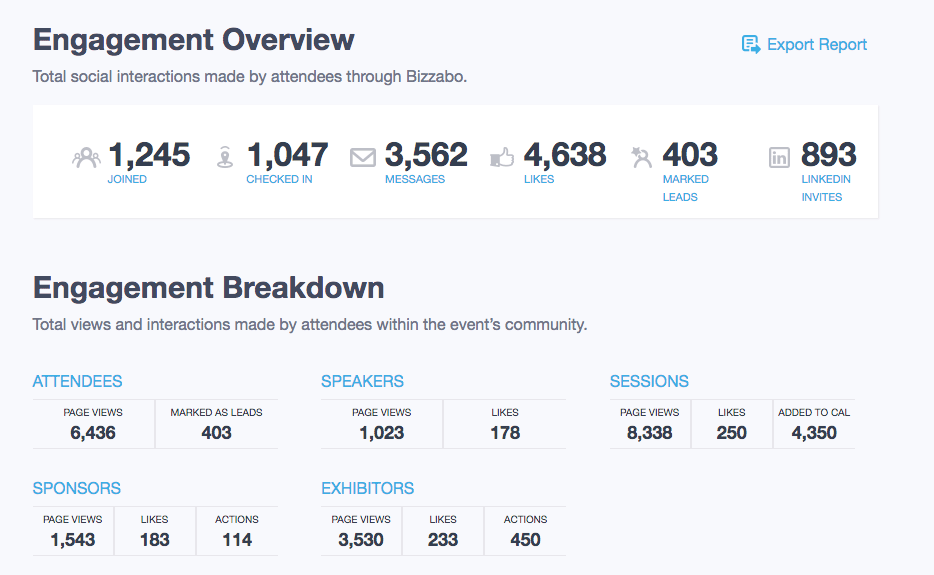Even if you are relatively new to email marketing, you know about list segmentation. When you segment your list, you’re siloing your audience into different categories in order to send the most relevant messages. It’s effective for all types of campaigns, most notably live event email marketing.
As an event marketer, you can achieve a lot using segmentation. You can drive registrations, increase event app adoption, encourage repeat customers, and much more. The more clearly you can articulate this goal, the easier it will be to slice the data in a way that aligns with your end objective.
By understanding segmentation in the context of objectives, campaigns will be in a better position to succeed and achieve their respective purpose. Today, we’re sharing how you can use email segmentation to meet your overarching event goals.
If your goal is to increase email subscribers…
When the event planning kicks off, spreading awareness is key. One of the best ways to achieve this awareness is by building your email subscriber list. Having a large list of subscribers will make future marketing campaigns easier to execute and communication much simpler.
If increasing subscribers is the goal, here are three data segmentations that would help to support this objective.
1. Use website activity to your advantage
Sending emails based on a the recipient’s activity on the event website is a good way to send content that is most relevant to their interests and thus persuade them to subscribe. Perhaps your data shows that a subgroup of visitors are clicking on your agenda page. Create a campaign that gives more sneak peeks into the agenda and segment this campaign to those who are clicking on the agenda page on your event website.
2. Take previous event attendance into account
Take contact information from previous years’ events and make sure that past attendees are receiving your emails. Based on historical data of what they found interested, send emails that address their interests and encourage them to subscribe.
3. Tailor strategies based on email engagement levels
Look into the email data and tailor different strategies for recipients with different engagement levels. For those who open and engage with the emails often, schedule campaigns that trigger more frequently and have a clear call-to-action button to subscribe to the mailing list. For those who do not engage as often, still send emails but have them be spread apart, with a “subscribe” call-to-action button being the focal point.
If your goal is to secure co-marketing opportunities…
Whether you are planning a store opening, a volunteer event, or a party, your event can be the perfect opportunity to drum up some press. Segmentation is an especially useful tactic for sourcing co-marketing sponsors or press.
When it comes to a task as significant as securing event partnerships, the message being sent must be as tailored and as relevant as possible. To ensure a positive reading experience for potential partners, consider segmenting your campaign based on the following data points.
4. Segment by seniority level
We know that segmenting by job role is a common way to execute campaigns but in this case, going one level higher and segmenting by seniority level would more closely align with the objective. As the goal here is to generate demand for potential co-marketing partners, make sure to send email campaigns to those in high enough positions to sign off on that decision. This will ensure that you are speaking to the right person.
5. Send campaigns based on NPS Score
Often times the partners that end up being most excited to promote your event are the ones who passionately believe in your event (or company) vision. Send campaigns to previous attendees who gave high NPS scores for your events in the past. As an added plus, these attendees—or their organizations—may be in a position to co-market your event.
For those unaware, NPS scores provide a method for gauging the experience of attendees.

By segmenting potential partners with high NPS scores, you are reaching out to those people who may already have been considering partnering with you, which will make for an easier close.
6. Use personalization
When sending email campaigns to secure co-marketing partnerships, email personalization is key. Emails having to deal with large partnerships should be as far from generic as possible. Use personalization such as first name, job role, and name of company throughout the email to make it seem that message was specifically tailored for the recipient. Readers will appreciate the personalization, further opening up the possibility for discussing co-marketing opportunities.
If your goal is to drive registrations…
Driving event registrations is probably the most common reason for email marketing campaigns among event marketers. The best campaigns are able to convince readers to register for the event as soon as they are done reading the email. Achieving such a goal is never easy, so check out the segmentation options below to help create campaigns.
7. Take advantage of custom fields function
Typically when someone registers for an event, they are required to fill out the standard contact and or billing information. For the savvy event marketer, there is the opportunity to learn more about your attendees than just that. Consider adding custom fields tailored to the goals of the event that you are hosting.
For instance, if you’re hosting a volunteer event, you can create a drop-down list of answers for the question “Which cause or you most passionate about?” In addition to influencing how that individual experiences the event, the answer to this question can also be used to drive attendees to events that are more in-line with their events in the future.
8. Segment based on location
Location is a significant differentiator among attendees, especially if your event attracts a global audience. By sending emails based on geographic region, the message will be that much more personalized. Whether that means sending an email during a country’s specific holiday or crafting an email that refers to the particularly cold weather, segmenting campaigns based on location will create a positive and memorable experience for the reader, increasing the possibility of registration.

9. Segment by registration stage
It’s not uncommon for someone to begin filling out a registration form for an event…and then to get distracted at some point before completing it. Some event registration platforms now include features that allow marketers to capture the information of these “almost-attendees” and follow up with content directed at completing that registration.
If your goal is to engage attendees after the event…
Once you’ve hit your registration goal, there still is a lot more work to do. An event can be the start in a contact’s relationship with your brand or it can be a touchpoint along the way.
How users engage with your events and the activities surrounding it will provide you with valuable context for follow-up campaign. Keep these segmentation points in mind.
10. Create content based on events and campaigns attended
By looking at the events that a contact has attended—and how they have interacted with your brand at those events—you can create content that is more uniquely tailored to them.
Consider how Anheuser Busch created a unique brand activation experience at SXSW. Using VR headsets they gave consumers the opportunity to explore the company’s primary brewing plant and complimented the experience.
To capitalize on this experience, assuming they collected contact information, Anheuser Busch’s event marketers could enroll these consumers in a unique top-of-the-funnel email workflow. The follow-up content would be different if, say, the attendee in question also signed up for a rewards program at the event.
11. Segment based on survey response
During the event registration process, you probably included a list of questions to better understand what attendees are most looking forward to. Segment your post-event follow-up campaigns based on these responses and craft the messages from an angle that directly reflects their answers. For example, if many attendees responded that they’re most enjoyed the speakers at your event, target those contact with an email that focuses on content around the the event’s past and future speakers.
12. Segment based on event app user data
If you’re using an event app, there’s a chance that you’ll have access to a treasure trove of valuable insights on your attendees. By looking at your event app analytics, you may be to see which attendees sent the most messages to other attendees, posted to social media via the app or just logged the most amount of time in the app. You can then leverage this data to identify who your events biggest champions are.
For instance, you could segment those attendees who talked about your event most in social media and thank them for keeping the conversation alive. Alternatively, those sent the most messages to other attendees may be interested in content that revolves around meeting other and networking.
Below is an example of how Bizzabo’s event app dashboard breaks down user data.

Whether you’re engaging with B2B or B2C audiences, there are a number insights that can be gleaned from event app user data.
Wrap up
Segmentation can be a powerful email strategy as long as the objective is clearly stated. In the hectic world of event marketing, goals and strategies can seem to overlap and the “why” behind each campaign starts to lose focus. As long as the campaign objective is articulated from the beginning, the segmentation strategy can be built around that objective and the results can be that much more impactful.





